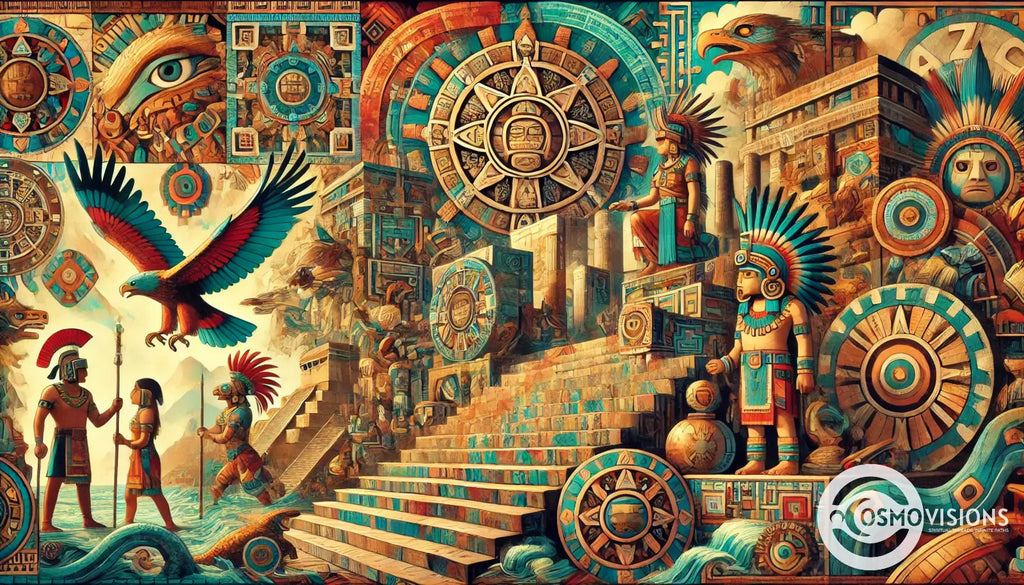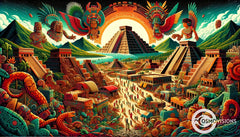Unlocking the Mysteries of the Nahuatl Language
Posted by Massimiliano Geraci

Are you curious about ancient languages? Many people find the past and its secrets fascinating. The Nahuatl language is one of these mysteries. It holds the key to understanding a culture that thrived long ago.
Did you know Nahuatl was spoken by the Aztecs in central Mexico centuries before Europeans arrived? This Aztec language was used in trade, literature, and as a language of prestige. It offers a window into their world and the various dialects that existed during their time.
In this article, we’ll explore Nahuatl's history, structure, and current status. You’ll also learn about its sounds and words and how some people in Mexico still use it.
We make it easy to follow along, even if you’re new to this topic. Ready for an adventure into history? Let’s start unraveling the story of Nahuatl together!
Key Takeaways
Today, over 1.44 million people speak Nahuatl in Mexico. It’s recognized as a national language and taught in some schools to keep the culture alive.

Historical Background of the Nahuatl Language in the Aztec Empire
The Nahuatl language, spoken by the powerful Aztec Empire, has a rich past. This ancient tongue used symbols in scripts to tell stories and record events before the Spanish arrived. During the early colonial period, Nahuatl was widely spoken in Mexico City and the Valley of Mexico before being displaced by the Spanish language.
Aztec Codices: Pre-Columbian Scripts
Aztec codices serve as windows into the soul of Pre-Columbian Mesoamerica. Crafted with meticulous care, these ancient scripts hold the history of a civilization that valued knowledge, spirituality, and art above all.
Traditional Aztec writing captured memories rather than sounds before adopting a syllabic script prior to Spanish conquest. Traditional Aztec writing was mnemonic, not phonetic, but evolved to a syllabic script before the Spanish conquest. Spanish religious orders later introduced Latin script. This change marked a significant transformation in documenting Indigenous languages and cultures across Mexico. These scripts were not merely records; they were narratives woven with spiritual significance and metaphoric language that spoke directly to the heart of those who understood their depth. Nahuatl became an early literary language after the Spanish conquest, with many texts written in it during the 16th and 17th centuries.

Examination of the Classical Nahuatl Language Structure
Exploring the structure of Nahuatl opens a door to its unique sounds and sentence patterns, inviting readers on a journey through its intricate design. Nahuatl also served as a lingua franca among diverse Mesoamerican societies, facilitating communication and trade.
Phonology and Morphology
Classical Nahuatl, an indigenous language, shows off a special set of sounds, known formally as its phonemic inventory. This array includes all the different noises (phonemes) that can change the meaning of a word in this ancient tongue.
Each sound plays a crucial role, making words distinct and rich in cultural resonance.
This language also weaves complexity with its nouns through obligatory inflections for traits like number and possession. Think of it as adding layers to each word, where every twist or turn changes its shade or meaning slightly.
These grammatical adornments are not just decoration but deeply alter how speakers connect with each other and their heritage.
Syntax and Vocabulary
Nahuatl language twists and turns with its unique structure. Its syntax stands out because every sentence is like a painting, full of vivid detail and life. This richness comes from “omnipredicativity,” where verbs are the stars.
They change form to show who’s doing what, when it’s happening, and how the doer feels about it. Imagine saying just one word in Nahuatl that tells a whole story—like an ancient tweet.
Words in this language borrow from Spanish too. Many modern Nahuatl words come from Spanish, mixing two worlds together. It’s like having friends over for dinner; you share your food but also try theirs.
And numbers? Nahuatl counts in twenties, not tens like we do. So next time you count something, think about doing it by twenties—it might just open up a new way of seeing things around you.
After the Spanish conquest, Nahuatl became a literary language with a significant corpus of texts, including histories, chronicles, poetry, theatrical works, Christian canonical works, ethnographic descriptions, and administrative documents.
Current Status and Use of the Nahuatl Language and Its Modern Dialects
Mexico’s General Law of Linguistic Rights of the Indigenous Peoples recognizes Nahuatl as a national language. This shows respect and acknowledgment for its importance. The Instituto Nacional de Lenguas Indígenas lists 30 different varieties, showing how diverse this language is.
Today, over 1.49% of people in ten states speak Nahuatl, totaling 1,448,937 speakers above five years old.
Many communities across Mexico keep the Nahuatl spirit alive, from bustling cities like Puebla and Veracruz to quiet corners in Tlaxcala and San Luis Potosí. Even in the United States, people in California and New York share stories in this ancient tongue.
Efforts to preserve the language are ongoing, with Nahuatl speakers playing a crucial role. Schools offer courses to teach more about this rich cultural heritage. With every word spoken or taught, the heart of ancient Mesoamerica beats stronger among us today.

Conclusion
Exploring the Nahuatl language and understanding how Nahuatl was spoken brings us closer to the wisdom of the Aztecs. Every word and phrase in Nahuatl offers us a glimpse into a rich past that shaped the present. By learning this language, we bridge worlds and times.
We keep alive a voice that might otherwise fade away. Our journey through its history, structure, and modern use lights up paths for future scholars and admirers alike.
Discover more about the fascinating script origins by exploring our dedicated page on Aztec codices: Pre-Columbian Scripts.
FAQs
1. What is Nahuatl, and where do people speak it?
Nahuatl, a gem from the Uto-Aztecan language family, once echoed through the valleys of Mexico as the language of the Aztecs. Spoken in central Mexico, today, 1.5 million voices keep its melodies alive, weaving through states and hearts with its ancient dialects.
2. How many varieties of Nahuatl are there?
Like stars in the sky, Nahuatl shines in multiple forms—each variety sparkling with its unique dialectical brilliance. These modern dialects continue to evolve, painting a rich tapestry of linguistic diversity across regions.
3. Can you find words in English that come from Nahuatl?
Yes! English borrows whispers from Nahuatl's past—words that carry the essence of ancient Mesoamerica into our everyday language, revealing hidden connections between cultures separated by time and geography.
4. Why did Nahuatl become so important in Latin American studies?
Nahuatl holds keys to understanding centuries-old civilizations—its words are bridges back to Aztec society. Scholars at institutions like Cambridge University Press delve into this prestigious language to uncover secrets nestled within early literary texts and administrative documents.
5. Are there courses available for learning Nahuatl?
Absolutely! From the halls of Indiana University to online platforms, curious minds have avenues to explore this linguistic relic—a journey back in time facilitated by dedicated courses aiming to revive and cherish an invaluable cultural heritage.
6. How has Spanish influenced Nahuatl since the Spanish Conquest?
The winds of history carried Spanish influences into the heartland of Nahuatl-speaking communities, intertwining two worlds through languages colliding yet coexisting—shaping each other on their shared path forward.






















